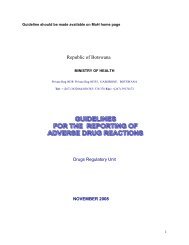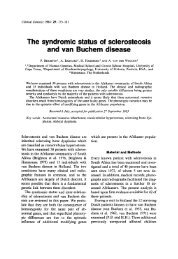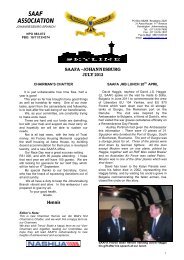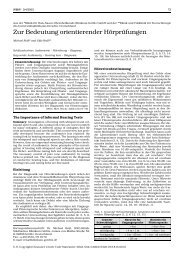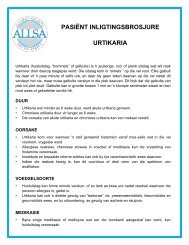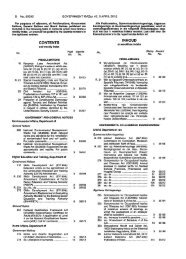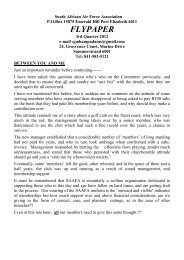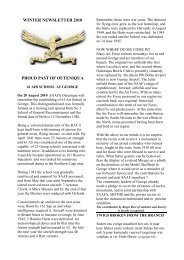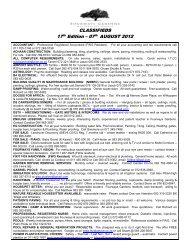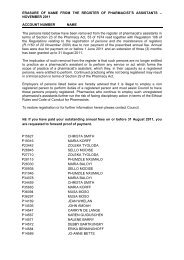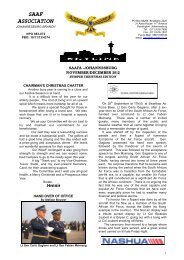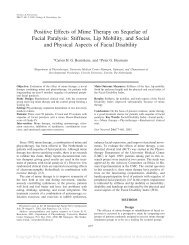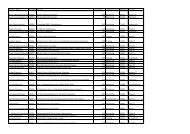Bell's Palsy: The Spontaneous Course of 2,500 Peripheral ... - Admin
Bell's Palsy: The Spontaneous Course of 2,500 Peripheral ... - Admin
Bell's Palsy: The Spontaneous Course of 2,500 Peripheral ... - Admin
Create successful ePaper yourself
Turn your PDF publications into a flip-book with our unique Google optimized e-Paper software.
Bell’s palsy 11<br />
Fig. 7. Proportion <strong>of</strong> patients who achieve complete recovery<br />
as a function <strong>of</strong> time <strong>of</strong> beginning recovery after the<br />
onset <strong>of</strong> paresis.<br />
third week had a signi cantly worse outcome (pB<br />
0.001). It is clear that the time <strong>of</strong> beginning remission<br />
is highly signi cant to the prognosis.<br />
Age <strong>of</strong> patients. Age is another parameter that<br />
in uences the nal result (Fig. 8). Children aged 514<br />
years had the most favorable prognosis, with 90%<br />
achieving full recovery. Patients aged 15–29 years<br />
had a fairly good chance <strong>of</strong> recovery (84%). <strong>The</strong><br />
chance <strong>of</strong> a full recovery was reduced for patients<br />
aged between 30 and 44 years (75%). Above the age<br />
<strong>of</strong> 45 years, the chances <strong>of</strong> recovery diminished signi<br />
cantly (64%). Above the age <strong>of</strong> 60 years, only<br />
about one-third <strong>of</strong> patients will experience the return<br />
<strong>of</strong> normal function. <strong>The</strong> in uence <strong>of</strong> age on the nal<br />
outcome is therefore highly signi cant (pB0.001).<br />
Postauricular pains. As noted above, postauricular<br />
pains were registered in 52% <strong>of</strong> all cases <strong>of</strong> Bell’s<br />
palsy. A total <strong>of</strong> 78% <strong>of</strong> patients with no pain regained<br />
normal function, as opposed to only 64% <strong>of</strong><br />
patients with pain (pB0.001).<br />
<strong>The</strong> prognostic value <strong>of</strong> topographical tests. It must<br />
be stressed that the examination <strong>of</strong> taste, stapedius<br />
re ex and tear ow or nasolacrimal re ex (Table<br />
Fig. 8. Age distribution <strong>of</strong> patients who achieve complete<br />
recovery.<br />
VIII) should be performed very carefully and always<br />
in exactly the same way or else the comparison <strong>of</strong><br />
results is meaningless. <strong>The</strong> results should not depend<br />
on the person performing the tests.<br />
Taste. <strong>The</strong> taste test according to Boernstein (36) is<br />
semiquantitative and based on recognition <strong>of</strong> four<br />
basic tastes—sweet, salt, sour and bitter—at three<br />
different concentrations. Initial taste examination<br />
showed that 83% <strong>of</strong> patients had partially reduced or<br />
abolished taste while 12% had normal taste. Final<br />
taste examination showed that 80% <strong>of</strong> patients had<br />
regained normal taste function. Taste function and<br />
the muscular function <strong>of</strong> the face normalized at approximately<br />
the same time.<br />
Stapedius re ex. <strong>The</strong> stapedius re ex is an acoustic<br />
facial re ex provoked on both sides by one-sided<br />
sound stimulation (37). Initially, 72% <strong>of</strong> patients had<br />
a reduced or abolished re ex and only 22% had a<br />
normal re ex. When remission occurs, stapedius<br />
re ex will usually return 1–2 weeks before visual<br />
function <strong>of</strong> the facial muscles can be con rmed.<br />
Normal function was restored in 86% <strong>of</strong> patients.<br />
Tearing or nasolacrimal re ex. <strong>The</strong> nasolacrimal<br />
re ex passes from the nasal mucosa to the superior<br />
salivary nucleus and thence to the secretory bers,<br />
with the facial nerve ending in the lacrimal gland. In<br />
this study a modi cation <strong>of</strong> Schirmer’s test II (38)<br />
was used, which is based on measurement <strong>of</strong> tear ow<br />
for 1 min. Stimulation with benzene is carried out for<br />
30 s and measurement is performed by using lter<br />
paper placed in the lower fornix. At the end <strong>of</strong> the<br />
test the length <strong>of</strong> the soaked strip <strong>of</strong> lter paper is<br />
measured on both sides. <strong>The</strong> difference between the 2<br />
sides is B20% in 95% <strong>of</strong> normal persons. Initially,<br />
11% <strong>of</strong> patients had partially reduced or abolished<br />
tearing. <strong>The</strong> nal result showed that 97% <strong>of</strong> patients<br />
achieved normal tearing. In comparison with taste<br />
and stapedius re ex testing, tearing became normal in<br />
a surprisingly high proportion <strong>of</strong> patients.<br />
Figure 9 shows the prognostic value <strong>of</strong> the three<br />
topographical tests. <strong>The</strong> patients were divided into<br />
two groups: one group with normal facial muscle<br />
function and the other with muscular sequelae. Comparison<br />
<strong>of</strong> the results <strong>of</strong> the initial taste tests for the<br />
groups with and without sequelae showed that 91%<br />
and 80% <strong>of</strong> patients, respectively had partially reduced<br />
or abolished taste (pB0.001). Concerning the<br />
stapedius re ex, it was found that 91% and 63% <strong>of</strong><br />
patients, respectively had a reduced or abolished<br />
re ex (pB0.001). <strong>The</strong> nasolacrimal re ex is also a<br />
reliable prognostic indicator because 27% and 5% <strong>of</strong><br />
patients, respectively had abolished or reduced<br />
lacrimal function (pB0.001). In conclusion, all three<br />
<strong>of</strong> the topographical tests provide reliable prognostic<br />
information.



